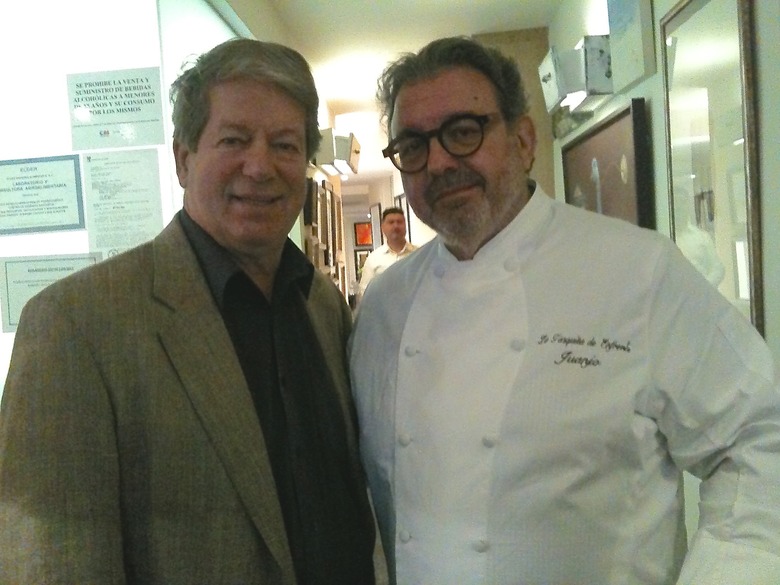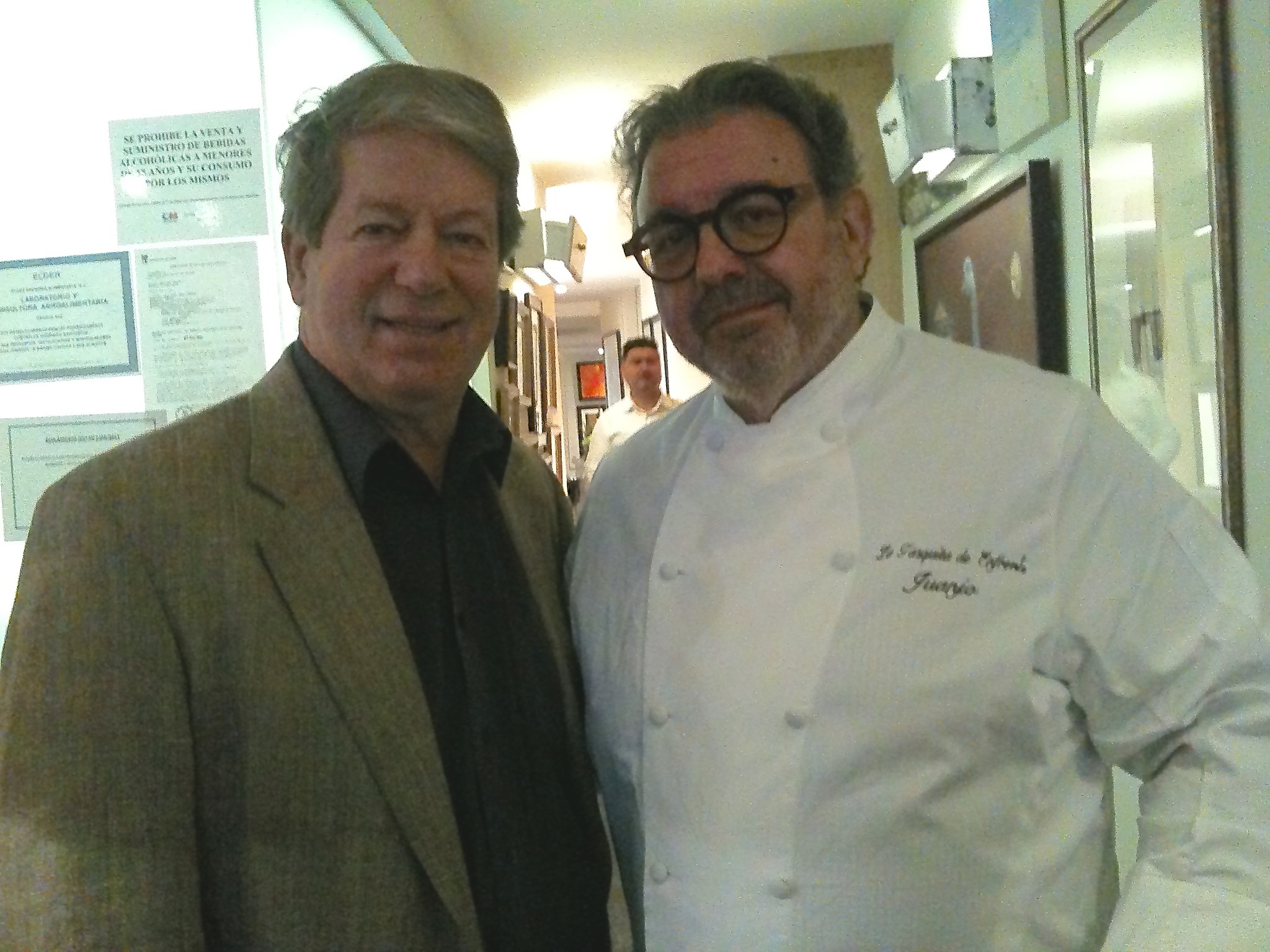La Tasquita De Enfrente: Madrid's Best Woodcock
Juanjo López's La Tasquita de Enfrente, which translates to "the little tavern across the street" opened 50 years ago across the street from his father's place, La Gran Tasca. Dedicated to simple home cooking with prime local products, La Tasquita has secured a place on just about anybody's list of top Madrid restaurants. Just north of Gran Vía in the shadow of the Telefónica building (Europe's earliest skyscraper, completed in 1929), La Tasquita is where an anthology of clued-in cognoscenti and stars of stage, screen, and cuisine meet to greet (and eat) in an intimate little dining room where you always feel lucky to have scored a table.
Calle de la Ballesta, long-famous as one of Madrid's seamiest flesh markets, adds morbo (prurient interest) to the scene and appetites tend to be raging by the time you cross Calle del Desengaño (which, not inappropriately perhaps, means "romantic disappointment, or disillusionment").
Chef and owner López greets clients as they straggle in around two, some rolling luggage on their way to the afternoon AVE back to Barcelona or Sevilla.
La Tasquita serves up a wide range of simple but perfectly prepared traditional Spanish favorites ranging from ensaladillas rusas and salmorejos to cuts of iberico ham or callos a la madrileña.
Most famously of all, in late fall and winter, La Tasquita specializes in woodcock, and Juanjo (short for Juan José), is a respected authority on the subject of woodcock cookery. "The woodcock we have today came from Asturias in northwestern Spain, but we get them from all over the Iberian Peninsula between October and late January. Naturally, with the faisandage or hanging time, we are still serving woodcock well into February. We handle between 200 and 250 woodcock a year."
I had called that morning around 10 and was beginning to feel very fortunate indeed to have secured not only a table, but a brace of woodcock for myself and a friend.
López described the hanging process so crucial to the proper preparation of the Scolopax Rusticola, the European woodcock, which is double the size of the American woodcock, the Scolopax Minor. "We hang them, undrawn of course, for 10-15 days at about 34 degrees Fahrenheit. Anything more than that and we're getting into necrophagia, which has never been my favorite thing. Thirty-five days is the maximum hang time I have ever tasted and, while there are game enthusiasts who like it that 'high,' I do not."
López went on to describe his woodcock cooking philosophy, from the "fondo," or stock, to the barely cooked breast meat to the more well-done legs. The "torrija," or toast, is soaked in the juices made from the woodcock heart, liver, and trail (entrails, which are sterile, as described in Larousse Gastronomique).
"For me," López adds, "the best bite is the head, which we split down the middle and grill on both sides to produce a well-cooked and brittle texture around the softer brains and crunchy beak."
Paco Pérez, at the moment the planet's only five-Michelin-starred chef (Miramar in Llançà, 2 stars; Enoteca in the Hotel Arts Barcelona, 2 stars; Miramar in the Hotel Das Stue, Berlin, 1 star) arrived with family and friends and settled into a table in the far corner as we took our miniscule table for two just inside the door. Suddenly the place was full and the 30-seat dining room was buzzing.
For the opening proposals — ensaladilla rusa, sea anemones, and menestra de verduras — sommelier Arturo Rivas (from Manlleu, near Vic, an hour north of Barcelona) suggested a bottle of Malcorta, a crisp white verdejo from the Rueda D.O. made by Javier Sanz with 100 percent verdejo grapes.
The ensaladilla rusa, or Russian salad, was López's tip of the cap to a traditional Spanish bar favorite, a concoction of finely chopped egg, potato, carrot, peas, pickles, and tuna first developed by chef Lucien Olivier in Moscow's famous restaurant Hermitage in 1860.
The ortiguillas, or sea anemones, were from Cádiz, where Mediterranean and Atlantic currents and the River Guadalquivir estuary combine to produce some of the Iberian Peninsula's finest seafood. The crispy tentacles and hot but soft body column yielded intense tastes and aromas of the sea.
The menestra de verduras was not a soup, not a stew, but a lightly steamed anthology of vegetables: a pick-up sticks of asparagus, yellow beet, rainbow beet, broccoli, cauliflower, carrots, Romanesco broccoli, turnip, rutabaga, Brussels sprouts, and baby spinach, all still perfectly crunchy.
Which brought us to the quid of the matter: the woodcock.
Accompanied by a Rey Fernando de Castilla, Oloroso Antique sherry from Jerez de la Frontera described by sommelier Rivas as a rich concentration of late autumnal and invernal aromas perfectly suited to game and especially the dark and pungent meat of the becada, the woodcock arrived. The spiky assemblage of beaks, thighs, breasts, and black truffle all arranged around (and held together by) a dollop of mashed potato was López's homage-to-the-woodcock sculpture and perfectly captured the spirit of this beautiful and much revered game bird. Accompanying was a glass of woodcock consommé.
The breast meat was, as López had described it, "the filet mignon" of the woodcock, the largest and most toothsome morsel, but the crunchy head and about half of the beak were, for me, the most interesting and most quintessentially woodcock part of the presentation. The flexible tip of the beak didn't crumble into easily swallowed chips and had to be abandoned, but everything else was eagerly devoured.
The flavor of woodcock flesh is dark; critics compare it to liver. The texture is tender and delicate unless the woodcock has been overcooked. The toast saturated with the trail pâté was as flavorful as the breast meat, while the mashed potato was an effective sponge for any leftover gravy. The black truffle chip, while aromatic, seemed almost ancillary amid this embarrassment of riches, an unusual fate for the often dominant Tuber melanosporum.
A homemade pumpkin flan with a Pedro Ximénez-Spínola Old Harvest sherry made of sun-dried Palomino grapes was the fragrant final act in this mid-winter feast and the walk to Atocha train station through Puerta del Sol, Plaza de Santa Ana, and the literary neighborhood was all but a stroll through the Elysian Fields.

